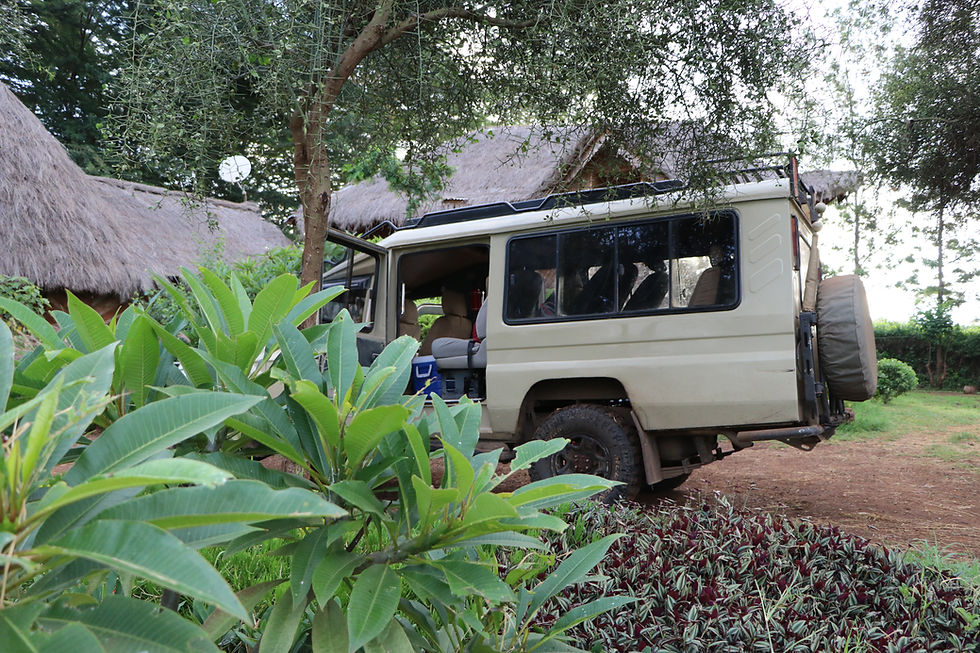Kenya Budget Travel: 10 tips & tricks
- Ine Vandenwyngaert
- Jan 20, 2020
- 6 min read
Updated: Nov 19, 2024
Do you want to travel around Kenya but you have a tight budget? We were in the same boat when we planned our 10-day journey around this incredibly diverse country. Even though Kenya’s infrastructure and steep park entrance fees make it challenging to travel cheaply, there is a way to overcome a few budget obstacles. This article highlights 10 budget-saving tips and tricks for your trip to Kenya.
Check out our video on Kenya to get a sense of what it's like there!
Kenya Travel Budget
During our 10 day trip through Kenya, we explored different regions and National Parks with a safari jeep. We spent approximately US$1,000, excluding our flight tickets to Kenya. This means that we had a budget of US$100 per day, which covered our accommodation, entrance fees for tourist attractions and parks, food and drinks, and jeep rental with the driver. This budget still allowed us to live the adventure we desired with the right comfort. Given that an organized 10-day tour around Kenya easily exceeds US$4,000, we managed well!
Kenya Price guidelines
Approx. exchange rate: US$1 = 100 Kenyan Shilling (KES)

Safaris, Beaches, Tribes, and Other Attractions
Tip 1: Plan your itinerary with diversity in mind
In spite of safaris usually being the main draw for travelers to explore Kenya, there is much more to discover. As stated before, Kenya is a diverse country which is reflected in its culture, people, wildlife, and landscapes. In addition to the national parks, Kenya offers splendid white-sand beaches, interesting tribes, and traditions, as well as historic sites. The beauty of our trip was the variety of activities we planned. We combined the safaris with beaches, culture, and cities. While safaris are undoubtedly the biggest expense, the beaches, and cities can be explored relatively cheaply. For example, we visited Diani Beach for a few days at the end of our trip to unwind, saving us some budget. We also explored the two biggest cities in Kenya, Nairobi, and Mombasa. Both cities have interesting sights, from local flea markets to historic sites.

Tip 2: Go on a jeep safari with a group
Most of Kenya’s National Parks are controlled by the government and therefore charge a fixed rate. The most popular National Parks and Game Reserves include the Maasai Mara, Amboseli, and the Great Rift Valley Lakes. While there is no way to avoid the park entrance fee (only Kenyan residents and citizens are eligible for a discount), you can save A LOT of money by renting the jeep with a larger group. A standard safari jeep typically has 8 seats (7 in the back and one next to the driver). As you pay a fee per day for the jeep including the driver, the more passengers you have, the cheaper it will be for everyone. We paid a total of US$200 for a 7 days jeep rental because we were able to share the cost among 8 people.
Maasai Mara National Park - US$80 per day
Amboseli National Park - US$60 per day
Tsavo East National Park - US$ 52 per day
Meru National Park - US$ 52 per day
Nairobi National Park - US$ 42 per day

Tip 3: Negotiate prices
Whenever you see the opportunity to negotiate, we recommend you do so! Bargaining over the price is an important part of the Kenyan culture, so you shouldn’t feel embarrassed. Haggling is especially important when taking a tuk-tuk or buying souvenirs and street food. We also managed to get a discount on our snorkeling excursion to Kisite-Mpunguti Marine National Park on the Kenyan Coast. We brought the price down from US$120 to US$30 per person (including entrance fee) by arranging our own transportation and excluding the provided lunch and other unnecessities.
Transportation
Tip 4: Take local transportation whenever possible
In towns and cities, you can move around by various means of local transportation: the tuk-tuk, matatu, and Uber. We used the tuk-tuk in Mombasa and smaller towns, while we found Uber more convenient in a big city like Nairobi. The tuk-tuk is a cheap option (if you negotiate well!) and is ideal for short distances. The matatu is probably the cheapest option but requires you to have a good sense of where you are going. Take local transportation whenever possible and don’t let the hotels convince you to take their expensive “taxis”.
Tip 5: Don’t self-drive
While you may think that self-driving is cheaper than booking a jeep safari, we don’t recommend it. Truth is that the drivers in the parks are connected to one another and communicate where to spot the animals. When you are self-driving you are likely to miss the most exciting and rare animal sightings. On top of that, the roads in the parks are challenging with many potholes and sometimes floods. You can easily get stuck if you drive yourself!

Accommodation
Tip 6: Book your accommodation outside the National Parks
Many travelers decide to stay within the National Parks during their trip to Kenya. This is a costly decision as you will need to pay multiple park entrance fees (the fee is usually valid for 24 hours only) and stay in a luxury resort. The food, drinks, and other facilities within the resort come at a price as well.
Alternatively, there are many cheaper hotels and eco-camps near the park entrance to choose from. Most neighboring towns or areas have a few low-budget options. For example, when we visited Tsavo East National Park, we stayed in the town of Voi. This town was right next to the park entrance, which is ideal if you want to have an early start.
Tip 7: Stay at hostels, AirBnBs, or low-budget hotels
Although the fancy resorts are mostly promoted, Kenya has a wide variety of other accommodation options. Each town usually has a few low-budget hotels and hostels for less than US$20 a night. Most rooms will come with a fan and a shared bathroom. Check out Hostelworld or Booking.com to find good deals. In addition, in major cities like Nairobi or Mombasa you will also have an attractive selection of AirBnBs. We rented an AirBnB in both Nairobi and Diani Beach, with good value for money.
Food & Drinks
Tip 8: Bring your lunch when visiting the National Parks
The National Parks in Kenya don't have many lunch options. Generally, it is only possible to get food and drinks at one of the luxury resorts, which are extremely pricey. Therefore, it is suggested to bring your own packed lunch and snacks into the jeep. Not only will you have more time to spot the animals, but you will also save a lot of money and frustration. We would buy bread, cakes, fruit, and chips. Kenyan Chevda (Tropical Heat flavor), was our favorite and was very cheap. It hit the spot on those long safari days!
Tip 9: Buy local food
If you're on a budget, we recommend not going out for food at luxury restaurants. Although the food is tasty at those restaurants, it is usually a similar price to what you would pay in North America or Europe for the same food. Instead of restaurants, opt-in for local cuisine whenever possible. You will get a much better bang for your buck and will also be able to enjoy pure Kenyan food. Local grocery stores also have cheaper options than restaurants for alcohol, water, and essential bread to get you through your adventures. Bring snacks with you at all times as there are sometimes long stretches of road without any gas stations or stores.

Tip 10: Don’t be afraid of street food
Street food in Kenya is nothing to be scared of! In fact, it's some of the best food in the country if you go to the right places. When walking the streets, stop in and talk to the local vendors to see what they have to offer and for how much. Food is not usually something to barter prices on in Kenya, but the street food is generally very cheap already. You shouldn't have to pay more than US$5 for a full meal on the streets and we found the quality to be very good at the places we tried. Just make sure to always give the booth a once-over before making your purchase. Check if the cooking area is sanitary, the utensils look clean, and there are no bugs in the area. Also, make sure to be careful when eating fruits or vegetables as the water to clean them may have been local water from the river. This water has often not been purified, and thus you may get an upset stomach if you eat those. Instead, opt for cooked meats, rice, and bread when possible. If you are afraid of getting sick, then check out our article with 7 tips on how to stay healthy while traveling.
Are you having a hard time planning your trip to Kenya? Get our Interactive Travel Planner to keep it all organized.
Find specific budget activities in Kenya from other sources
This post contains a few affiliate links. That means we may earn a small commission when you click on the links at no additional cost to you. You can read our full disclaimer here. Thanks for supporting our travel blog!















コメント